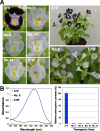Application of the CRISPR/Cas9 system for modification of flower color in Torenia fournieri
- PMID: 30518324
- PMCID: PMC6280492
- DOI: 10.1186/s12870-018-1539-3
Application of the CRISPR/Cas9 system for modification of flower color in Torenia fournieri
Abstract
Background: CRISPR/Cas9 technology is one of the most powerful and useful tools for genome editing in various living organisms. In higher plants, the system has been widely exploited not only for basic research, such as gene functional analysis, but also for applied research such as crop breeding. Although the CRISPR/Cas9 system has been used to induce mutations in genes involved in various plant developmental processes, few studies have been performed to modify the color of ornamental flowers. We therefore attempted to use this system to modify flower color in the model plant torenia (Torenia fournieri L.).
Results: We attempted to induce mutations in the torenia flavanone 3-hydroxylase (F3H) gene, which encodes a key enzyme involved in flavonoid biosynthesis. Application of the CRISPR/Cas9 system successfully generated pale blue (almost white) flowers at a high frequency (ca. 80% of regenerated lines) in transgenic torenia T0 plants. Sequence analysis of PCR amplicons by Sanger and next-generation sequencing revealed the occurrence of mutations such as base substitutions and insertions/deletions in the F3H target sequence, thus indicating that the obtained phenotype was induced by the targeted mutagenesis of the endogenous F3H gene.
Conclusions: These results clearly demonstrate that flower color modification by genome editing with the CRISPR/Cas9 system is easily and efficiently achievable. Our findings further indicate that this system may be useful for future research on flower pigmentation and/or functional analyses of additional genes in torenia.
Keywords: CRISPR/Cas9; Flavanone 3-hydroxylase; Flower color; Genome editing; Torenia fournieri.
Conflict of interest statement
Ethics approval and consent to participate
Not applicable
Consent for publication
Not applicable
Competing interests
The authors declare that they have no competing interests.
Publisher’s Note
Springer Nature remains neutral with regard to jurisdictional claims in published maps and institutional affiliations.
Figures



Similar articles
-
Molecular characterization of mutations in white-flowered torenia plants.BMC Plant Biol. 2014 Apr 2;14:86. doi: 10.1186/1471-2229-14-86. BMC Plant Biol. 2014. PMID: 24694353 Free PMC article.
-
Production of multi-petaled Torenia fournieri flowers by functional disruption of two class-C MADS-box genes.Planta. 2020 Apr 24;251(5):101. doi: 10.1007/s00425-020-03393-3. Planta. 2020. PMID: 32333191
-
Simultaneous targeting of duplicated genes in Petunia protoplasts for flower color modification via CRISPR-Cas9 ribonucleoproteins.Plant Cell Rep. 2021 Jun;40(6):1037-1045. doi: 10.1007/s00299-020-02593-1. Epub 2020 Sep 21. Plant Cell Rep. 2021. PMID: 32959126
-
CRISPR/Cas9 System: A Potential Tool for Genetic Improvement in Floricultural Crops.Mol Biotechnol. 2022 Dec;64(12):1303-1318. doi: 10.1007/s12033-022-00523-y. Epub 2022 Jun 25. Mol Biotechnol. 2022. PMID: 35751797 Free PMC article. Review.
-
Induced mutation and epigenetics modification in plants for crop improvement by targeting CRISPR/Cas9 technology.J Cell Physiol. 2018 Jun;233(6):4578-4594. doi: 10.1002/jcp.26299. Epub 2018 Jan 4. J Cell Physiol. 2018. PMID: 29194606 Review.
Cited by
-
Anthocyanin metabolic engineering of Euphorbia pulcherrima: advances and perspectives.Front Plant Sci. 2023 May 15;14:1176701. doi: 10.3389/fpls.2023.1176701. eCollection 2023. Front Plant Sci. 2023. PMID: 37255565 Free PMC article. Review.
-
Genetic Transformation of Torenia fournieri L. with the Bacillus thuringiensis Cry1Ab Gene Confers Resistance to Mythimna separata (Walker).Plants (Basel). 2024 Dec 20;13(24):3568. doi: 10.3390/plants13243568. Plants (Basel). 2024. PMID: 39771266 Free PMC article.
-
Molecular characterization of an anthocyanin-related glutathione S-transferase gene in Japanese gentian with the CRISPR/Cas9 system.BMC Plant Biol. 2020 Aug 6;20(1):370. doi: 10.1186/s12870-020-02565-3. BMC Plant Biol. 2020. PMID: 32762648 Free PMC article.
-
Development of Improved Fruit, Vegetable, and Ornamental Crops Using the CRISPR/Cas9 Genome Editing Technique.Plants (Basel). 2019 Dec 13;8(12):601. doi: 10.3390/plants8120601. Plants (Basel). 2019. PMID: 31847196 Free PMC article. Review.
-
Mechanisms of Salt Tolerance and Molecular Breeding of Salt-Tolerant Ornamental Plants.Front Plant Sci. 2022 Apr 27;13:854116. doi: 10.3389/fpls.2022.854116. eCollection 2022. Front Plant Sci. 2022. PMID: 35574092 Free PMC article. Review.
References
-
- Akita Y, Morimura S, Loetratsami P, Ishizaka H. A review of research on ower-colored mutants of fragrant cyclamens induced by ion-beam irradiation. Horticult Int J. 2017;1:90–91.
MeSH terms
Substances
Grants and funding
LinkOut - more resources
Full Text Sources
Other Literature Sources

